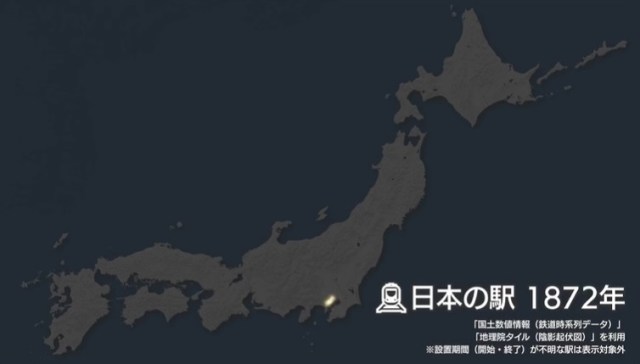
Points of light shine bright, and sometimes disappear, in this fascinating look at the last century and a half.
It’s hard to imagine Japan without trains. Whether it’s the Shinkansen zooming past Mt. Fuji or a Yamanote Line commuter train packed with office workers, railways are connected to some of the most iconic images of the country.
And yet, you don’t have to go all that far back, historically speaking, to get to a time when Japan didn’t have any trains at all. It was in 1872 that the very first train line opened in Japan, when Tokyo’s Shimbashi Station was connected what is now Sakuragicho Station in Yokohama, meaning that there’s been a rapid rail-ification of Japan in the time since, and to illustrate how it happened, Japanese Twitter user @ShinagawaJP has created a fascinating time-lapse-style video showing markers for every station in the country.
「駅」の移り変わりを動画にしてみた。鉄道開業から150年、時代とともに鉄道の役割、顔つきが変わっていくのが興味深い。タイムマシンでこの地図の続きを見てみたい。(・ㅅ・)#30DayMapChallenge Day 1: Points - Railway Stations in Japan pic.twitter.com/hgaGYrLgcg
— にゃんこそば🌤データ可視化 (@ShinagawaJP) November 2, 2022
With each station represented by a point of light, Japan starts with just two. It’s not long before more appear, though, with the area around Osaka and western Hokkaido being the next illuminated.
▼ 1882
The pace really picks up after the Meiji restoration in 1888, when Japan ended centuries of feudal rule by the shogunate and modernization could take place. A year later, Tokyo and other Kanto region cities are connected with Kyoto, Osaka, and the other major communities of Kansai. Before the turn of the century, Western Japan’s Chugoku region and the Hokuriku area, on the north side of Japan’s main island of Honshu, get their first stations, as do the islands of Shikoku and Kyushu.
▼ 1895
In 1925, pretty much the entire country is outlined in stations, and the area in between starts getting more and more filled in, and the concentration of stations seems to hit its peak in the 1960s.
▼ 1925
▼ 1960
While the areas around Japan’s largest cities maintain their station density, in some other regions you can see lights going out as stations end their rail service. The phenomenon is especially noticeable in Hokkaido, @ShinagawaJP explains, as coal mines began shutting and as people moved away from the most remote, mountainous parts of the prefecture. Increases in personal car ownership as Japan enjoyed an economic boom in the 1960s, ‘70s, and ‘80s likely played a part too, as Hokkaido’s size and low population density make it a part of Japan where driving is often more convenient than taking the train.
▼ Time-lapse for Hokkaido
北から南へ眺めてみる。
— にゃんこそば🌤データ可視化 (@ShinagawaJP) November 2, 2022
北海道の鉄道は栄枯盛衰。炭鉱が去り、中山間地域では人口減少が加速。生活インフラから地域のコミュニティまで、まさに"都市をたたむ"時代を迎えている。
※饗庭 伸 氏『都市をたたむ』・・・閉鎖(shut down)ではなく縮小(fold up)の意味 pic.twitter.com/GOXIkLza53
In the video focused on west Japan, we can see Kyushu go through a Hokkaido-like contraction, once again, @ShinagawaJP says, as a result of mining shutdowns.
九州では明治期から石炭鉱業が盛んで、水運などを置き換える形で鉄道が発達。
— にゃんこそば🌤データ可視化 (@ShinagawaJP) November 2, 2022
その多くはエネルギー転換とともに使命を終えたが、うまいこと通勤列車にジョブチェンジした路線も。
地図では分かりにくいですが、路面電車が多いのも西日本の特徴。久々に長崎・思案橋をぶらついてみたい。(・ㅅ・) pic.twitter.com/6ZFE0suokl
In Tohoku, trains first looped along the seashore before connections to the more mountainous interior sprouted.
こちらは東北地方。
— にゃんこそば🌤データ可視化 (@ShinagawaJP) November 2, 2022
大動脈(東北本線など)から静脈(各都市を結ぶ中小路線)が生えていく様子が面白い。
※元データ(国土数値情報)には抜け漏れ・誤りがあります。全体的な変化を楽しんでいただければ。 pic.twitter.com/X0baomciG5
And last, the Kanto-to-Kansai span is where you’ll find the most populous cities in Japan, and so the areas around Tokyo, Nagoya, and Osaka all just get brighter and brighter.
煌々と輝く関東~関西。
— にゃんこそば🌤データ可視化 (@ShinagawaJP) November 2, 2022
ただ、よく見ると”血行”の悪い盲腸線が淘汰されているのが分かる。駅の間引きもちらほら。
大量輸送と新幹線連絡、そのどちらも満たせないローカル線はこの先生きのこれるか。 pic.twitter.com/50cR9xBJpx
“I wish I had a time machine so I could see what’s coming next for these maps,” @ShinagawaJP says. We’ll just have to wait and see, but at least while we wait for the next 150 years of train history in Japan we can search for those 150 hidden train station Pokémon.
Source: Twitter/@ShinagawaJP via IT Media
Images: Twitter/@ShinagawaJP
● Want to hear about SoraNews24’s latest articles as soon as they’re published? Follow us on Facebook and Twitter!

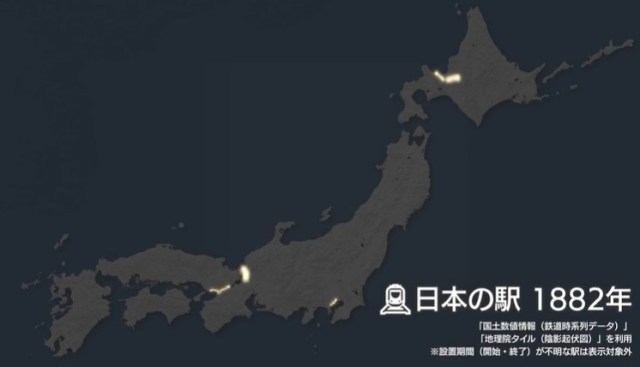
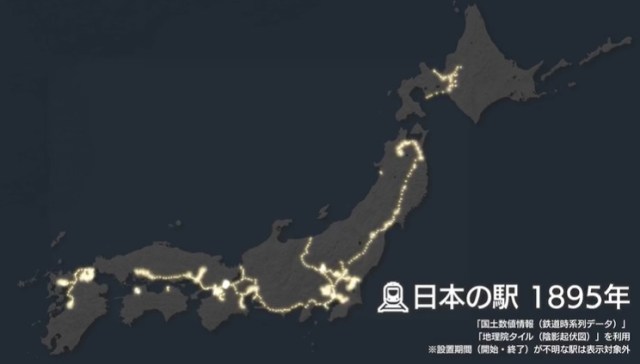
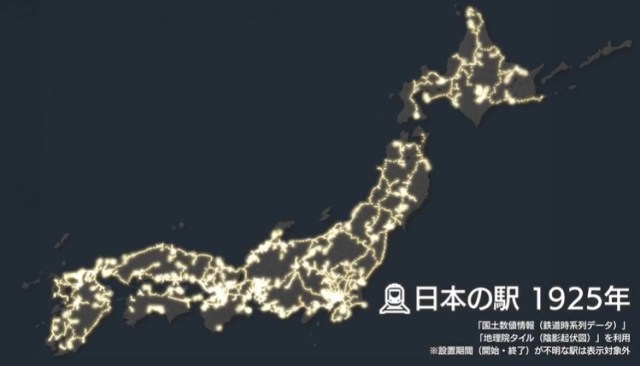
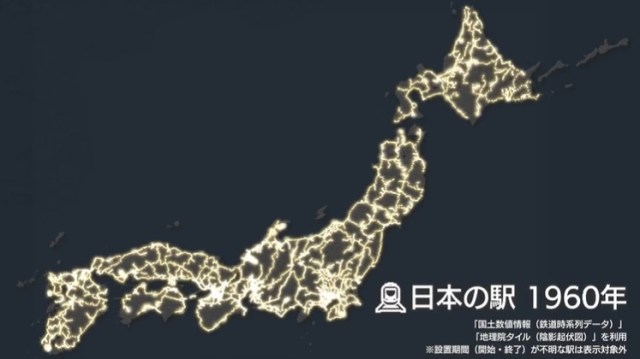
 New JR Shinkansen-inclusive rail pass is a huge bargain, great way to help out a region in need
New JR Shinkansen-inclusive rail pass is a huge bargain, great way to help out a region in need Foreign passenger shoves conductor on one of the last full runs for Japan’s Thunderbird train
Foreign passenger shoves conductor on one of the last full runs for Japan’s Thunderbird train A message from Japanese train station toilet paper: Don’t stare at your smartphone while walking
A message from Japanese train station toilet paper: Don’t stare at your smartphone while walking Tokyo travel alert: City’s most important train line shutting down for construction this weekend
Tokyo travel alert: City’s most important train line shutting down for construction this weekend Get your chills on the rails with Kyoto’s Ghost Train 【Video】
Get your chills on the rails with Kyoto’s Ghost Train 【Video】 How to order snacks on a Shinkansen bullet train in Japan
How to order snacks on a Shinkansen bullet train in Japan New Pokémon ice cream, dessert drinks, and cool merch coming to Baskin-Robbins Japan【Pics】
New Pokémon ice cream, dessert drinks, and cool merch coming to Baskin-Robbins Japan【Pics】 Japan’s new difficult-to-drink-from beer glass protects your liver, but it’s a brutal experience
Japan’s new difficult-to-drink-from beer glass protects your liver, but it’s a brutal experience Demon Slayer: Kimetsu no Yaiba gets new roller coaster attractions and food at Universal Studios Japan
Demon Slayer: Kimetsu no Yaiba gets new roller coaster attractions and food at Universal Studios Japan Burger King Japan suddenly adds Dr. Pepper and Dr. Pepper floats to its menu nationwide
Burger King Japan suddenly adds Dr. Pepper and Dr. Pepper floats to its menu nationwide High-fashion Totoro cuddle purse is like an elegant stroll in the forest【Photos】
High-fashion Totoro cuddle purse is like an elegant stroll in the forest【Photos】 Hello, cosmetics! Clinique teams up with Hello Kitty this summer for first-time collaboration
Hello, cosmetics! Clinique teams up with Hello Kitty this summer for first-time collaboration To combat declining birth rate, Japan to begin offering “Breeding Visas” to foreigners
To combat declining birth rate, Japan to begin offering “Breeding Visas” to foreigners Russian crocodile hospitalized after woman falls on it
Russian crocodile hospitalized after woman falls on it Starbucks Japan welcomes alpacas for cute summer drinkware line【Photos】
Starbucks Japan welcomes alpacas for cute summer drinkware line【Photos】 Nintendo history you can feel – Super NES, N64, and GameCube controllers become capsule toys
Nintendo history you can feel – Super NES, N64, and GameCube controllers become capsule toys “The most Delicious Cup Noodle in history” – Japan’s French Cup Noodle wins our heart【Taste test】
“The most Delicious Cup Noodle in history” – Japan’s French Cup Noodle wins our heart【Taste test】 Starbucks releases a cute Frappuccino and Unicorn Cake…but not in Japan
Starbucks releases a cute Frappuccino and Unicorn Cake…but not in Japan Kyoto Tower mascot termination reveals dark side behind cute Japanese characters
Kyoto Tower mascot termination reveals dark side behind cute Japanese characters McDonald’s Japan’s Soft Twist Tower: A phantom ice cream only sold at select branches
McDonald’s Japan’s Soft Twist Tower: A phantom ice cream only sold at select branches Yabai Ramen: What makes this Japanese ramen so dangerous?
Yabai Ramen: What makes this Japanese ramen so dangerous? Finally! Nintendo Japan expands Switch 8-bit controller sales to everybody, Online member or not
Finally! Nintendo Japan expands Switch 8-bit controller sales to everybody, Online member or not Japanese government wants to build luxury resorts in all national parks for foreign tourists
Japanese government wants to build luxury resorts in all national parks for foreign tourists 10 things you should buy at 7-Eleven in Japan
10 things you should buy at 7-Eleven in Japan Studio Ghibli releases anime heroine cosplay dresses that are super comfy to wear
Studio Ghibli releases anime heroine cosplay dresses that are super comfy to wear Woman charged for driving suitcase without a license in Osaka
Woman charged for driving suitcase without a license in Osaka Studio Ghibli unveils My Neighbour Totoro miniature house model
Studio Ghibli unveils My Neighbour Totoro miniature house model Kyoto experiencing problems with foreign tourists not paying for bus fares, but not on purpose
Kyoto experiencing problems with foreign tourists not paying for bus fares, but not on purpose Fighting mild hunger with a Japanese soda that turns into jelly in the stomach【Taste test】
Fighting mild hunger with a Japanese soda that turns into jelly in the stomach【Taste test】 Studio Ghibli’s Howl’s Moving Castle tapestry unveiled in Japan for first time
Studio Ghibli’s Howl’s Moving Castle tapestry unveiled in Japan for first time McDonald’s new Happy Meals offer up cute and practical Sanrio lifestyle goods
McDonald’s new Happy Meals offer up cute and practical Sanrio lifestyle goods Sales of Japan’s most convenient train ticket/shopping payment cards suspended indefinitely
Sales of Japan’s most convenient train ticket/shopping payment cards suspended indefinitely Sold-out Studio Ghibli desktop humidifiers are back so Totoro can help you through the dry season
Sold-out Studio Ghibli desktop humidifiers are back so Totoro can help you through the dry season Japanese government to make first change to romanization spelling rules since the 1950s
Japanese government to make first change to romanization spelling rules since the 1950s Foreigner’s request for help in Tokyo makes us sad for the state of society
Foreigner’s request for help in Tokyo makes us sad for the state of society Ghibli founders Toshio Suzuki and Hayao Miyazaki contribute to Japanese whisky Totoro label design
Ghibli founders Toshio Suzuki and Hayao Miyazaki contribute to Japanese whisky Totoro label design Doraemon found buried at sea as scene from 1993 anime becomes real life【Photos】
Doraemon found buried at sea as scene from 1993 anime becomes real life【Photos】 Tokyo’s most famous Starbucks is closed
Tokyo’s most famous Starbucks is closed Princesses, fruits, and blacksmiths: Study reveals the 30 most unusual family names in Japan
Princesses, fruits, and blacksmiths: Study reveals the 30 most unusual family names in Japan New Japan rail pass gives you a week of free rides in a huge space to chase the cherry blossoms
New Japan rail pass gives you a week of free rides in a huge space to chase the cherry blossoms You can go surprisingly far on a single train leaving from Tokyo Station
You can go surprisingly far on a single train leaving from Tokyo Station Tokyo airport’s new train line to make getting into, out of the city easier for JR pass holders
Tokyo airport’s new train line to make getting into, out of the city easier for JR pass holders Japan’s new random-destination die-roll train tickets — Amazing bargain for just 36 bucks
Japan’s new random-destination die-roll train tickets — Amazing bargain for just 36 bucks Tokyo train company makes sweet addition to stations so that birds can keep their nests in them
Tokyo train company makes sweet addition to stations so that birds can keep their nests in them Hello Kitty Shinkansen bullet train to debut in Japan this summer
Hello Kitty Shinkansen bullet train to debut in Japan this summer Crazy busy overnight work experience event for Japanese kids gives them just four hours to sleep
Crazy busy overnight work experience event for Japanese kids gives them just four hours to sleep Want to choose the name of Tokyo’s most important new station? Here’s your chance!
Want to choose the name of Tokyo’s most important new station? Here’s your chance! Vending machine makes commuters smile at Japanese train station
Vending machine makes commuters smile at Japanese train station These are the 11 most crowded trains in Japan…and surprise! They’re all in the Tokyo area
These are the 11 most crowded trains in Japan…and surprise! They’re all in the Tokyo area Tokyo’s busiest train line to be partially shut down this weekend as part of Shibuya renovations
Tokyo’s busiest train line to be partially shut down this weekend as part of Shibuya renovations Why do seats at some Japanese station platforms face away from the trains?
Why do seats at some Japanese station platforms face away from the trains? Woman kills self jumping onto train tracks, delay causes conductor to jump off tracks at other station
Woman kills self jumping onto train tracks, delay causes conductor to jump off tracks at other station 12 beautiful Japanese train stations by the sea
12 beautiful Japanese train stations by the sea Studio Ghibli animators’ West Japan Railway ad has us ready for summer! 【Video】
Studio Ghibli animators’ West Japan Railway ad has us ready for summer! 【Video】
Leave a Reply